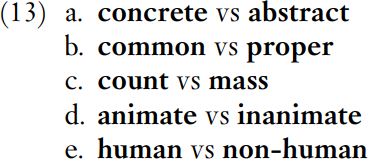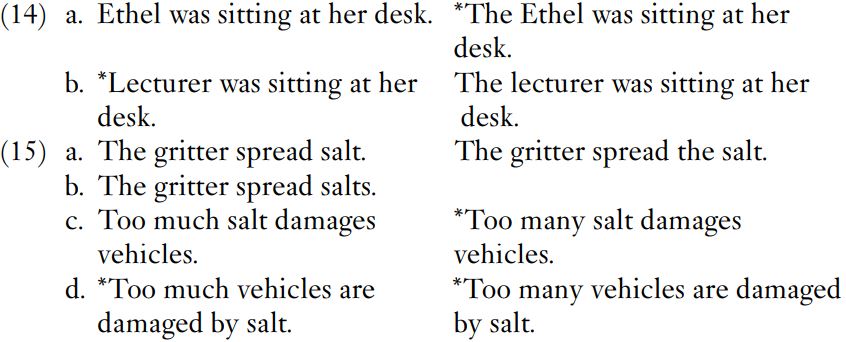

Grammar


Tenses


Present

Present Simple

Present Continuous

Present Perfect

Present Perfect Continuous


Past

Past Simple

Past Continuous

Past Perfect

Past Perfect Continuous


Future

Future Simple

Future Continuous

Future Perfect

Future Perfect Continuous


Parts Of Speech


Nouns

Countable and uncountable nouns

Verbal nouns

Singular and Plural nouns

Proper nouns

Nouns gender

Nouns definition

Concrete nouns

Abstract nouns

Common nouns

Collective nouns

Definition Of Nouns

Animate and Inanimate nouns

Nouns


Verbs

Stative and dynamic verbs

Finite and nonfinite verbs

To be verbs

Transitive and intransitive verbs

Auxiliary verbs

Modal verbs

Regular and irregular verbs

Action verbs

Verbs


Adverbs

Relative adverbs

Interrogative adverbs

Adverbs of time

Adverbs of place

Adverbs of reason

Adverbs of quantity

Adverbs of manner

Adverbs of frequency

Adverbs of affirmation

Adverbs


Adjectives

Quantitative adjective

Proper adjective

Possessive adjective

Numeral adjective

Interrogative adjective

Distributive adjective

Descriptive adjective

Demonstrative adjective


Pronouns

Subject pronoun

Relative pronoun

Reflexive pronoun

Reciprocal pronoun

Possessive pronoun

Personal pronoun

Interrogative pronoun

Indefinite pronoun

Emphatic pronoun

Distributive pronoun

Demonstrative pronoun

Pronouns


Pre Position


Preposition by function

Time preposition

Reason preposition

Possession preposition

Place preposition

Phrases preposition

Origin preposition

Measure preposition

Direction preposition

Contrast preposition

Agent preposition


Preposition by construction

Simple preposition

Phrase preposition

Double preposition

Compound preposition

prepositions


Conjunctions

Subordinating conjunction

Correlative conjunction

Coordinating conjunction

Conjunctive adverbs

conjunctions


Interjections

Express calling interjection

Phrases

Sentences


Grammar Rules

Passive and Active

Preference

Requests and offers

wishes

Be used to

Some and any

Could have done

Describing people

Giving advices

Possession

Comparative and superlative

Giving Reason

Making Suggestions

Apologizing

Forming questions

Since and for

Directions

Obligation

Adverbials

invitation

Articles

Imaginary condition

Zero conditional

First conditional

Second conditional

Third conditional

Reported speech

Demonstratives

Determiners


Linguistics

Phonetics

Phonology

Linguistics fields

Syntax

Morphology

Semantics

pragmatics

History

Writing

Grammar

Phonetics and Phonology

Semiotics


Reading Comprehension

Elementary

Intermediate

Advanced


Teaching Methods

Teaching Strategies

Assessment
Classes of nouns
المؤلف:
Jim Miller
المصدر:
An Introduction to English Syntax
الجزء والصفحة:
53-5
31-1-2022
1921
Classes of nouns
Selectional restrictions, as hinted above, lead us to employ large subclasses of nouns that are familiar from traditional grammar. The subclasses are set out in 13.

These subclasses were established in traditional grammar not just for the analysis of English but for the analysis of all the languages of Europe. They have been extended to the analysis of languages all over the world – many languages outside Europe have particularly intricate sets of distinctions. We have brought in these subclasses in connection with selectional restrictions, which are closely connected with semantics. A very important point, however, is that the distinctions set out in (13) are relevant to the grammar of many languages. We are not suggesting that all the distinctions are relevant to the grammar of every language, but any sample of languages from different language families and different areas of the world will show that each distinction affects the grammar of some languages. For example, English proper nouns such as Ethel typically exclude the and a, using the examples reproduced below as (14). Common nouns, which are not the names of people, towns and so on, typically allow or require the or a, for example lecturer in (14b), gritter and salt in (15a).
 The distinction between common and proper nouns does have a semantic component; proper nouns are the names of people, places, organizations and institutions. The distinction is also very important for the grammar of English noun phrases; proper nouns such as Ethel in (14a) exclude the, and singular common nouns such as lecturer in (14b) require the. (The plural does not – Lecturers all wear food-stained pullovers and sandals is impeccable in its grammar even if not in its content.)
The distinction between common and proper nouns does have a semantic component; proper nouns are the names of people, places, organizations and institutions. The distinction is also very important for the grammar of English noun phrases; proper nouns such as Ethel in (14a) exclude the, and singular common nouns such as lecturer in (14b) require the. (The plural does not – Lecturers all wear food-stained pullovers and sandals is impeccable in its grammar even if not in its content.)
The distinction between count and mass nouns is involved in important grammatical choices but likewise has a meaning component. With respect to grammar, mass nouns require much, as in (15c), and exclude many; count nouns require many and exclude much. With respect to meaning, count nouns refer to entities that are thought of as individuals, that can be counted – boy, plant, idea. Mass nouns denote entities that are conceived of as a mass of stuff that cannot be split into countable individuals – water, flour, wine, salt. Mass nouns typically occur in the singular; when they occur in the plural, they change their meaning. Wines has the interpretation ‘kinds of wine’
In other languages, the distinctions between the subclasses of nouns are relevant for the assignment of case, for example. This is demonstrated by the two Russian examples in (16).

Stakan in (16a) is inanimate and has no case suffix. Kot is animate and takes the case suffix -a. Other patterns in the Russian case system involve the distinction between concrete and abstract and between count and mass, but we omit the details.
We close this section with a comment on the terms ‘concrete’ and ‘abstract’. Lecturer and wine are examples of concrete nouns, while truth and amazement are abstract nouns. We are using the traditional labels, but the key distinction is whether a given noun denotes an entity that is abstract or not abstract. The difficulty is that ‘concrete’ evokes an entity made of the substance called ‘concrete’, or at least an entity that is hard and solid. Lecturers are not made of the substance we call ‘concrete’ and wine is not solid, but neither wine nor lecturers are abstract. They can be physically seen, touched and manipulated, whereas truth and amazement canon.
 الاكثر قراءة في Syntax
الاكثر قراءة في Syntax
 اخر الاخبار
اخر الاخبار
اخبار العتبة العباسية المقدسة

الآخبار الصحية















 قسم الشؤون الفكرية يصدر كتاباً يوثق تاريخ السدانة في العتبة العباسية المقدسة
قسم الشؤون الفكرية يصدر كتاباً يوثق تاريخ السدانة في العتبة العباسية المقدسة "المهمة".. إصدار قصصي يوثّق القصص الفائزة في مسابقة فتوى الدفاع المقدسة للقصة القصيرة
"المهمة".. إصدار قصصي يوثّق القصص الفائزة في مسابقة فتوى الدفاع المقدسة للقصة القصيرة (نوافذ).. إصدار أدبي يوثق القصص الفائزة في مسابقة الإمام العسكري (عليه السلام)
(نوافذ).. إصدار أدبي يوثق القصص الفائزة في مسابقة الإمام العسكري (عليه السلام)


















